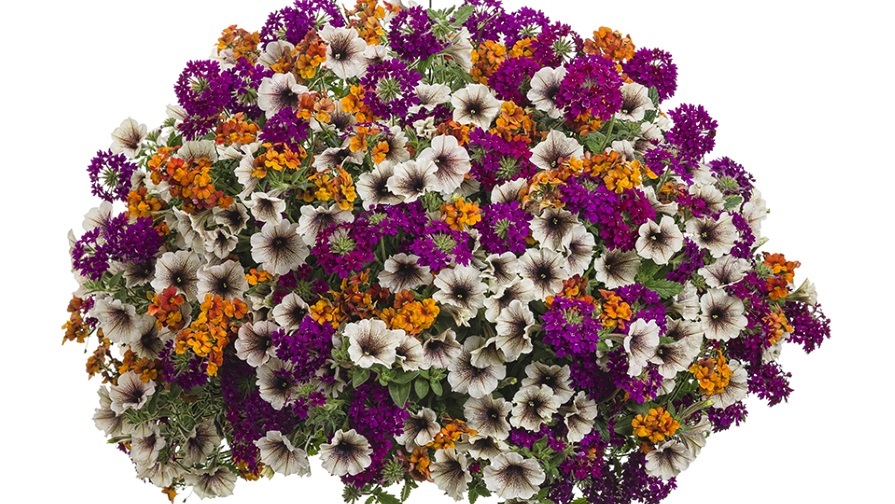Production Tips For Top Performers: Gaillardia ‘Oranges & Lemons’

Gaillardia, commonly known as blanket flower, has adorned many traditional perennial gardens. Recently, a number of new cultivars of this drought-tolerant North American native have been introduced. This year at OFA Short Course, there were several new cultivars of gaillardia displayed and many of them are trial worthy. After trialing several great gaillardia cultivars for their greenhouse performance, we were particularly impressed with ‘Oranges and Lemons.’
As the name suggests, this cultivar has cheery, peachy-yellow flowers that almost gleam in the sunlight. In the MSU trial gardens (USDA cold hardiness Zone 5), ‘Oranges and Lemons’ has over-wintered in two separate locations for the last three years, and it continues to bloom all summer long without deadheading. Gaillardia ‘Oranges and Lemons’ is as easy to produce in flower as it is to grow in a garden.
Starting Material
Since ‘Oranges and Lemons’ is patented, its unlicensed propagation is prohibited. We used 72-cell rooted plugs in our experiments. At receipt, the plugs had flower buds that were pinched off before transplant. Young plant producers have reported that unrooted cuttings initiate flowers during propagation and can be difficult to root. We have noticed that some gaillardia cultivars do not tolerate excessive moisture, and increasing aeration by adding extra perlite to the propagation medium has been helpful in promoting rooting. Also, once rooted, plugs should be quickly moved off the mist benches and weaned on a non-misted bench before transplanting or bulking to avoid problems with root rot.
Forcing
We used pinched plugs with four to six leaves as a starting material for 5.5-inch containers in our trials. We forced all plants in a glass greenhouse set at a constant 68ËšF. Since all plants flowered and typically filled the pots at flowering, bulking is not essential. However, if using larger containers, bulking under a short-day photoperiod may be beneficial. Alternatively, multiple plugs can be planted per container to fill the pot by finishing time.
Unlike earlier cultivars such as ‘Goblin,’ ‘Oranges and Lemons’ does not require an exposure to cold, also known as vernalization treatment, for flowering. In our trials, all cooled and non-cooled plants flowered (Figure 1 A and B). We cooled plugs in trays for 15 weeks in a cooler set at 41ËšF under a 12-hour photoperiod provided by fluorescent lamps (~20 footcandles of light). Plugs survived well in the cooler and can easily be stored for up to 15 weeks under these conditions.
Cooling did not influence the flowering time, although the cooled plants had more flower buds and were more branched. This increase in flower bud number and branching was likely due to higher total light (daily light integral, DLI) received by the plants as they were forced in early summer in contrast with the non-cooled plants that were forced early in the spring.
Interestingly, the newly introduced cultivars of many herbaceous perennials are day-neutral or near day-neutral and flower under all photoperiods, and ‘Oranges and Lemons’ is no exception. Most traditional gaillardia cultivars are long-day plants and typically flower when the photoperiod exceeds 14 hours. In our trials, ‘Oranges and Lemons’ flowered under either short-day (nine hours) or long-day (16 hours) photoperiods. Note that under short-day photoperiods, plants were still “rosetted” in appearance, were only 4 to 7 inches tall and had only one to five flower buds per plant. In contrast, plants under long-day photoperiods were 15 to 20 inches tall and had two to 20 buds, depending on the DLI received by the plants. Therefore, horticulturally speaking, ‘Oranges and Lemons’ is a long-day plant. Providing a short-day photoperiod may be beneficial to keep stockplants, cuttings in propagation, and bulking transplants largely vegetative.
All gaillardia cultivars we have worked with, including ‘Oranges and Lemons,’ thrive when produced under a high DLI. When grown under supplemental lighting, plants were more compact and had more branches and flower buds.
Crop Culture
We forced ‘Oranges and Lemons’ in a peat-based medium and irrigated when necessary using a complete fertilizer containing macro and micro nutrients at the rate of 125 ppm nitrogen. Although we did not evaluate the influence of specific plant growth regulator applications on the height control of ‘Oranges and Lemons,’ paclobutrazol, daminozide and uniconazole have been effective in controlling the heights of other gaillardia cultivars.









